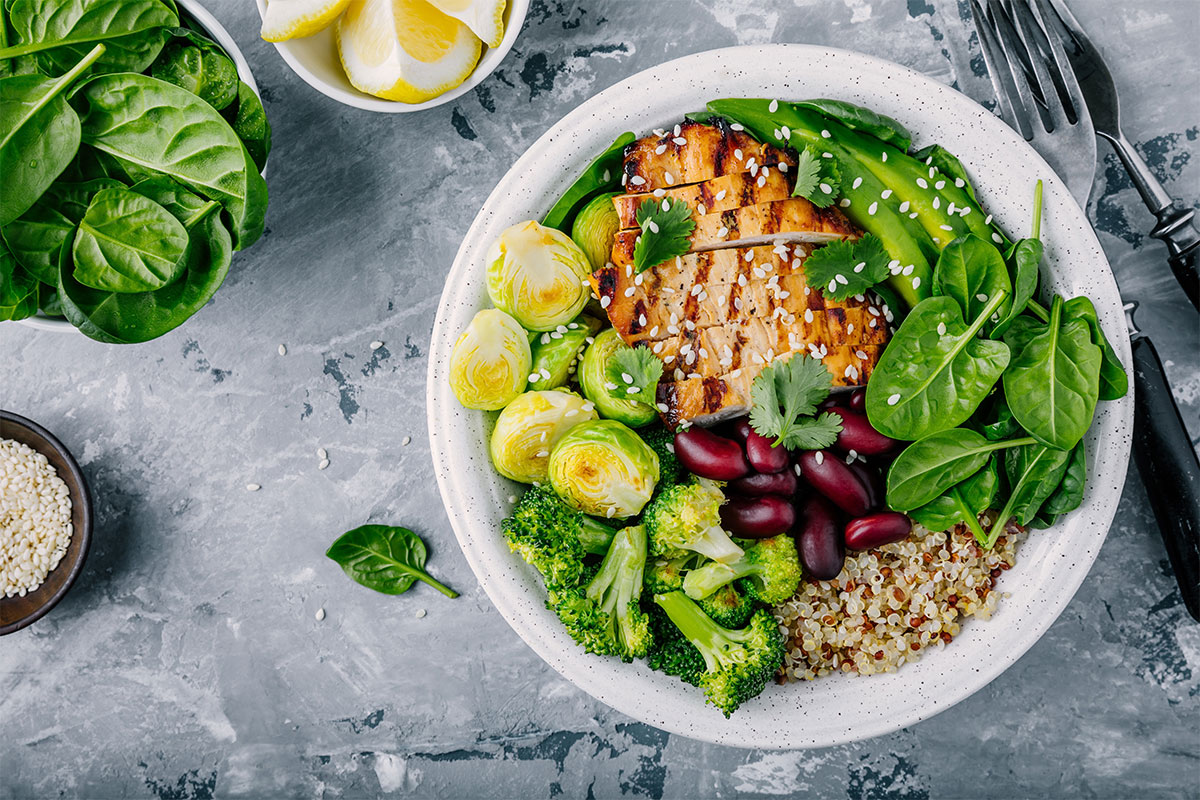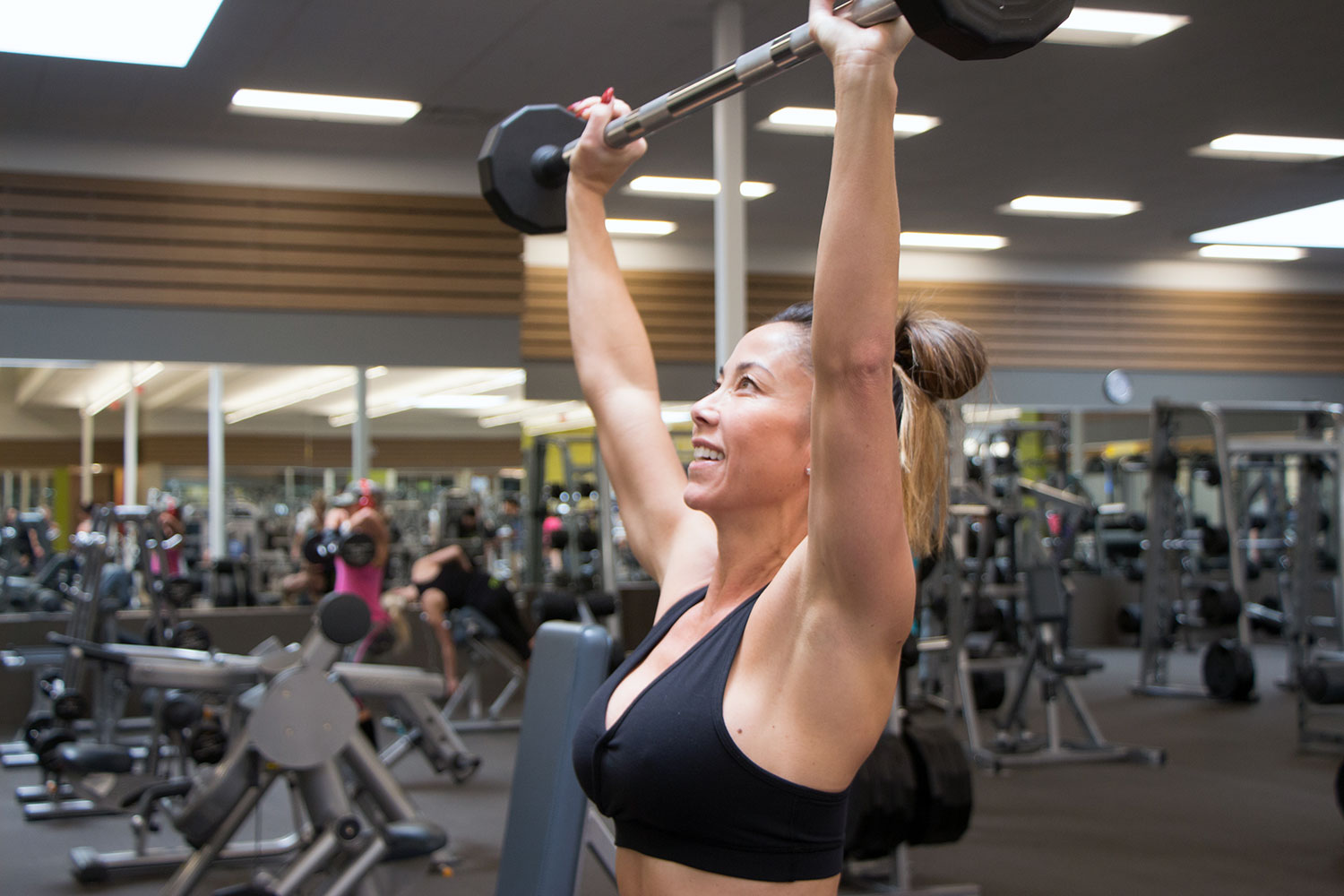How to Determine Your Macro Breakdown
LA Fitness registered dietitian, Debbie James, helps a member better understand how to determine her macro breakdown and which carbohydrates are good for you!


Hi my name is Alex, I am a 22–year–old male, about 5’5” in height, and I weigh about 123 pounds. I recently have changed my diet from regular eating to plant–based food which seems to give me more energy and better sleep. I was curious about how many macronutrients I should be getting and how many calories I should eat. I work out about 5-6 times a week, do cardio first for about 20-30 minutes, and then do about 45-60 minutes of intense cardio and weightlifting.
Thank you,
– Alex

Using a predictive energy calculation* it seems your total energy expenditure (TEE) falls in the range of 2600-2800 calories per day based on resting energy need + physical activity where the PA factor is 1.27 for active men. To determine macronutrient amounts, you could allocate 50-60% of energy to carbohydrates, 15-20% to protein and the remaining 20-35% to fat given your exercise level and reliance on plant foods. From 2700 calories and the midpoint of each macro range, this would calculate to about 370 gm Carb., 122 gm Prot., and 81 gm Fat daily.
Your macronutrient needs and goals shouldn’t really change much based on the source of your food. However, switching to eating all plants (strictly vegan) may mean getting fewer micronutrients if not done properly. So amping up your consumption of iron, zinc, magnesium and calcium may necessitate an adjustment in diet to increase plant sources of those minerals. Please see the Institute of Medicine’s Dietary Reference Intake tables of vitamins and minerals for your micronutrient intake targets.
*TEE for men = 864 − 9.72 × age (years) + PA × [(14.2 x weight (kg) + 503 × height (meters)]
Equation source:
Gerrior S, Juan W, Basiotis P. An easy approach to calculating estimated energy requirements. Prev Chronic Dis [serial online] 2006 Oct [date cited]. Available from: http://www.cdc.gov/pcd/issues/2006/
oct/06_0034.htm. Accessed 1.24.2020
– Debbie J., MS, RD
This article should not replace any exercise program or restrictions, any dietary supplements or restrictions, or any other medical recommendations from your primary care physician. Before starting any exercise program or diet, make sure it is approved by your doctor.
Some questions have been edited for length and/or clarity.
 Have a nutrition question? Our registered dietitian is ready to help!
Have a nutrition question? Our registered dietitian is ready to help!
Email nutrition@lafitness.com or submit your question below and it may be featured in an upcoming article!
LA Fitness registered dietitian, Debbie James, helps a member better understand how to determine her macro breakdown and which carbohydrates are good for you!
Do you count your macros? How do macro-nutrients and bodybuilding correlate? We did the research, so you have the answers.
Learn helpful nutrition tips from The Official LA Fitness Living Healthy blog. What are micronutrients and how do they affect the body? Find out here!


I would like to know how I determine what my macro breakdown should be? How do I know how to calculate my split as far as protein/fats/carbs based on my weight & height? And what carbs are good for me? Female, Weight 170 lbs., Height 5’2’, Weightlift 5 days per week Cardio 3-5 times per week. I need help (guidance) with the nutrition part of my weight loss journey.
– Yolanda G.

Given your current exercise regimen, your estimated daily energy needs for weight loss are about 2,000 calories if 20-30 years old (subtract 75 calories per decade older). Not knowing anything about your present intake, I’d recommend a rough caloric distribution of 30% fat, 20% protein, and 50% carbohydrates. Breaking down the 2,000 calories would give us 67 gm fat, 100 gm protein and 250 gm carbohydrate per day.
I’m so glad you asked about which carbohydrates are good! That indicates you’re aware that quality matters as much as quantity – for all three macronutrients. Complex carbohydrates that are more wholesome (less refined) are preferred over processed sources. Think of oats, quinoa, corn, potatoes, and vegetables complimented by simple carbohydrates from fresh fruit and milk products.
Here’s a one-day sample 2,000 calorie menu providing 27% fat, 22% protein, and 51% carbs*:
3 Snacks –
* Calculated by Registered Dietitian Nutritionist using Fitday.com’s food log function. Findings were used along with RDN’s professional judgment.
– Debbie J., MS, RD
This article should not replace any exercise program or restrictions, any dietary supplements or restrictions, or any other medical recommendations from your primary care physician. Before starting any exercise program or diet, make sure it is approved by your doctor.
Some questions have been edited for length and/or clarity.
 Have a nutrition question? Our registered dietitian is ready to help!
Have a nutrition question? Our registered dietitian is ready to help!
Email nutrition@lafitness.com or submit your question below and it may be featured in an upcoming article!
LA Fitness registered dietitian, Debbie James, helps a member better understand how to determine her macro breakdown and which carbohydrates are good for you!
Do you count your macros? How do macro-nutrients and bodybuilding correlate? We did the research, so you have the answers.
Learn helpful nutrition tips from The Official LA Fitness Living Healthy blog. What are micronutrients and how do they affect the body? Find out here!


I have done body building in the past and know that the perfect combination of protein/carbs/fats produce results with respect to giving the body what it needs to develop lean muscle and lose fat. This is done in part by measuring body fat and weight. How would you calculate this because I had someone do it for me in the past and don’t know how to do it myself. It was broken down into total protein, carbs and fats for the whole day and further broken down per meal. Can you duplicate this process?
– Alisa O.

I will admit that I am not sure what “perfect combination” of macro-nutrients you are referring to. One’s individual body composition can be used to help create personal nutritional goals. Actual nutrient needs are much more complex and depend on protein turnover, nitrogen loss and metabolism. Also, nutrient quality, timing and frequency have an impact on developing lean muscle and losing fat.
That said, I like the summary bodybuilding recommendations from an article in the Journal of the International Society of Sports Nutrition*:
Diet component Recommendation
Protein (g/kg of lean body mass) 2.3-3.1
Fat (% of total calories) 15-30%
Carbohydrate (% of total calories) remaining
Let’s work through these with a sample 2,000 calorie diet for a 160-pound person with 15% body fat.
Apply the recommendations to your own anthropometrics and total energy need to get a possible ideal combination of macro-nutrients for your goals.
*Evidence-based recommendations for natural bodybuilding contest preparation: nutrition and supplementation. Helms, ER, Aragon AA, Fitschen PJ. Journal of the International Society of Sports Nutrition 201411:20
– Debbie J., MS, RD
This article should not replace any exercise program or restrictions, any dietary supplements or restrictions, or any other medical recommendations from your primary care physician. Before starting any exercise program or diet, make sure it is approved by your doctor.
Some questions have been edited for length and/or clarity.
 Have a nutrition question? Our registered dietitian is ready to help!
Have a nutrition question? Our registered dietitian is ready to help!
Email nutrition@lafitness.com or submit your question below and it may be featured in an upcoming article!
LA Fitness registered dietitian, Debbie James, helps a member better understand how to determine her macro breakdown and which carbohydrates are good for you!
Do you count your macros? How do macro-nutrients and bodybuilding correlate? We did the research, so you have the answers.
Learn helpful nutrition tips from The Official LA Fitness Living Healthy blog. What are micronutrients and how do they affect the body? Find out here!


I am confused about macro nutrients. Can you clarify what this means and how I can use this to help lean out? Please help me understand what macro nutrients are and how it can help me lean down.
– Marlyn L.

Macronutrients are simply the classes of nutrients needed in large amounts, which includes carbohydrate, fat and protein. These provide energy in the form of calories (carb and protein 4 cals/gm, fat 9 cals/gm). Alcohol – not a nutrient – is the other food molecule that has calories (7 cals/gm). While the remaining 3 essential nutrients – water, vitamins and minerals – have zero calories.
Your current diet includes all 3 macronutrients. To say “use macronutrients” to help you lean out, seems to imply a structured ratio of the three. I will speak to this below, but first let me say that the overwhelming body of evidence regarding weight loss diets show that it’s a moderate restriction of calories, regardless of method, that achieves long-term weight loss.
What should your MACRONUTRIENTS intake be?
Each person’s effective macronutrient distribution for leaning out may be different. Are the changes required to meet a desired ratio sustainable for your lifestyle? How different is the proportion of macronutrients from what you’re currently eating? The US Dietary Guidelines recommend 10-30% calories from protein, 25-35% calories from fat and 45-65% calories from carbohydrate for healthy adults. You could reach your goals with 10% protein, 35% fat and 55% carbohydrate as easily as you might with 30% protein, 25% fat and 45% carbohydrate, assuming your activity level and energy intake are appropriate.
If you do decide to adhere to set percentages from each macronutrient, the act of tracking and analyzing your intake to determine your balance may be a major promotor of dietary change, thus caloric intake and weight loss. See our previous article: Keep a Food Diary, Log or Journal and Lose Weight Faster.
– Debbie J., MS, RD
This article should not replace any exercise program or restrictions, any dietary supplements or restrictions, or any other medical recommendations from your primary care physician. Before starting any exercise program or diet, make sure it is approved by your doctor.
LA Fitness will be open for Independence Day and Canada Day! Modified clubs hours are below!Holiday Hours (U.S.) Monday, July 4th: 8AM - 4PM Tuesday, July 5th: Normal Hours Holiday Hours (Canada) Friday, July 1st: 8AM - 4PM Saturday, July 2nd: Normal Hours ...
LA Fitness will be open for parts of the Holiday Season! Modified clubs hours are below!Holiday Hours (U.S.) Friday, December 24th: 8AM - Noon Saturday, December 25th: Closed Friday, December 31st: 8AM - 6PM Saturday, January 1st: 8AM - 6PM Holiday Hours...
Today is the 3rd Anniversary of the Living Healthy Podcast, presented by LA Fitness. Hi everyone! I just wanted to give you a quick update on what is going on with the show. We are trying to plan out 3 LIVE podcast episodes covering Exercise, Nutrition, and Sleep...
Want more? SUBSCRIBE to receive the latest Living Healthy articles right in your inbox!
Be the first to know about exclusive
content, deals and promotions